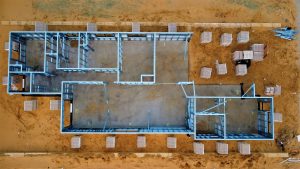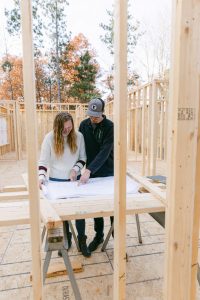
Building a home involves a series of meticulously planned steps, each critical to ensuring the structure’s stability, functionality, and aesthetic appeal. Here’s a breakdown of the key phases of the construction process:
Site Preparation
The construction process begins with site preparation, where the land is cleared and graded to create a stable foundation. Land clearing involves removing trees, rocks, and debris, while grading ensures proper drainage and a level base for the foundation. Once the site is prepared, the foundation is laid. The choice of foundation—whether it’s a slab, crawl space, or full basement—depends on factors such as soil type, climate, and the home’s design. A strong foundation is crucial as it supports the entire structure and prevents future issues like settling or water intrusion.
 Framing
Framing
After the foundation is complete, the focus shifts to framing, where the home’s structural skeleton is built. This includes erecting the walls, roof trusses, and floor joists, which define the shape and size of the house. The framing process also includes installing temporary supports to ensure the structure remains stable as the build progresses. Once the frame is in place, the roof is added, a critical step in protecting the home from the elements during the rest of the construction process.
Roofing
With the structural framework in place, the next step is roofing. The roof provides protection from the elements and plays a significant role in the home’s overall aesthetic. Roofing materials vary widely, from asphalt shingles and metal roofing to tile or wood shakes, each offering different levels of durability, cost, and maintenance. The installation process involves laying down a waterproof barrier, followed by the roofing material itself, ensuring a secure and weatherproof seal.
Exterior Work
Once the home is enclosed, exterior work begins. This includes installing siding, windows, and doors, which not only protect the home but also contribute to its curb appeal. Siding options, such as vinyl, wood, or brick, are chosen based on durability, maintenance, and aesthetic preference. Properly installed windows and doors enhance energy efficiency and security while allowing natural light and ventilation into the home.
Plumbing, Electrical, and HVAC
With the exterior sealed, it’s time to install the essential systems: plumbing, electrical, and HVAC (Heating, Ventilation, and Air Conditioning). These systems are critical to the home’s functionality and comfort. Plumbing involves running pipes for water supply, drainage, and sewage. The electrical system includes wiring for lights, outlets, and appliances, while the HVAC system ensures proper heating, cooling, and air quality. Opting for energy-efficient options, such as high-efficiency furnaces, programmable thermostats, and low-flow fixtures, can reduce long-term operating costs and increase the home’s value.
 Insulation and Drywall
Insulation and Drywall
Once the essential systems are in place, insulation is added to the walls, ceilings, and floors to regulate the home’s temperature and reduce energy consumption. Thermal insulation helps maintain a comfortable indoor climate, while sound insulation can be installed in certain areas to reduce noise transmission. After insulation, drywall is hung on the interior walls and ceilings, creating a smooth surface for finishing. The drywall is then taped, mudded, and sanded to prepare for painting or other wall treatments.
Interior Finishes
With the walls finished, attention turns to interior finishes. This stage involves installing flooring, such as hardwood, tile, or carpet, as well as cabinetry, countertops, and trim work. Painting is done at this stage, along with the installation of fixtures like light switches, outlets, and appliances. These elements define the home’s interior style and are often the most customizable aspects of the build.
Final Touches
The construction process concludes with the final touches, which include landscaping, driveways, and walkways. Landscaping not only enhances curb appeal but also provides functional outdoor spaces. Driveways and walkways are paved or laid with stone to provide access and durability. These final elements bring the project to completion, making the house ready for occupancy.

 Facebook
Facebook
 X
X
 Pinterest
Pinterest
 Copy Link
Copy Link

 Framing
Framing
 Insulation and Drywall
Insulation and Drywall
